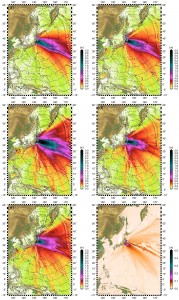地物、物理跨領域研究成果 -以海嘯模擬結果推衍日本311大地震不同震源破裂面模型之合理性
本所地物組張翠玉教授邀物理組邱銘達博士、詹森教授合作,以海嘯模擬探討2011年日本東北(Tohoku-Oki)大地震的震源破裂模型,他們選取5個已發表於學術期刊的不同破裂面模型驅動海嘯,比較模擬海嘯與DART浮標記錄的海嘯波高資料來權衡這5個破裂面模型的合理性,各個模型的海嘯模擬如附圖。研究結果顯示,以Yamazaki et al. (2011)破裂面模型為驅動場模擬之海嘯與DART資料比較誤差最小,代表主震最可能是發生在日本海溝邊緣一狹窄範圍內大規模之淺層滑動。這項研究也驗證了海洋密度分層和潮汐效應,對海嘯主波各會造成約5%和1%誤差,從海嘯預警的實用性來說,這兩項海洋效應可略去。本項研究論文即將刊登於Terrestrial, Atmospheric and Oceanic Sciences,詳細內容請待正式出版後可參閱全文,論文原始摘要附於下。
Abstract
Developing realistic, three-dimensional ruptures corresponding to a regional plate convergence is difficult to accomplish directly through band-limited ground-motion observations. A potential indirect method for this evaluation is to use a tsunami simulation to verify the rupture model reversely because the initial conditions of the associated tsunamis are caused by a coseismic seafloor correlating to the rupture pattern along the main faulting. In this study, five well-developed rupture models, Models I to V, that were used for the 2011 Tohoku-Oki earthquake were adopted to discriminate the differences between simulated tsunamis and various rupture asperities. Models I to V are Ammon et al. (2011), Lee et al. (2011), Yamazaki et al. (2011), Fujii et al. (2011), and Maeda et al. (2011). The leading wave of the simulated tsunamis triggered by the seafloor displacement of Model III obtained the smallest root-mean-squared difference (~0.082m on average) from the records of the eight DART (Deep-ocean Assessment and Reporting of Tsunamis) stations in the model domain, indicating that the main seismic rupture should occur in a large shallow slip in a narrow range adjacent to the Japan trench in the 2011 Tohoku earthquake. This study also quantified the influences of ocean stratification and tides, which are normally overlooked, on tsunami simulation. The discrepancy between the simulations with and without stratification was less than 5% of the first peak wave height at the eight DART stations. The simulations, run with and without the presence of tides, resulted in a ~1% discrepancy in the height of the leading wave. Because simulations that include tides and stratification are time-consuming and their influences are negligible, particularly in the first tsunami wave, the two factors can be ignored in a tsunami prediction for practical purposes.

模擬海嘯主波之分布,圖(a)-(e)分別是以Ammon et al. (2011)、Lee et al. (2011)、Yamazaki et al. (2011)、Fujii et al. (2011)、Maeda et al. (2011)的主震震源破裂面模型為驅動條件所得之結果;圖(f)是以2個最大餘震破裂面模型為驅動條件所模擬之海嘯。圖(c)與此海域8個DART浮標資料比較誤差最小。












